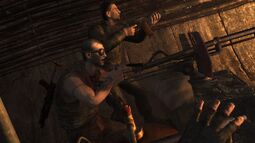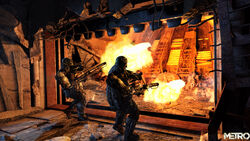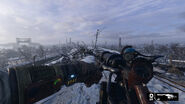| “ | This makeshift pneumatic flamethrower does not have an awful lot of range, but it more than makes up for that with its lethality and remarkable ability to use almost any fuel available in the Metro. | „ |
— Last Light in-game description | ||
The Flamethrower is a gaseous propellant-based weapon that was created from scrap by the Metro dwellers at some point after the Great War of 2013. On numerous occasions, it proved to be much more effective in protecting survivors than any other conventional weapon.
Overview[]
| “ | Let's kick some snout butts! | „ |
— Riga Militia | ||
Flamethrowers are highly revered weapons known for a multitude of capabilities including raw offensive and defensive power, and a reputation as tools of psychological warfare. The narrow nature of the Metro tunnels makes it frighteningly effective against human and mutant opponents alike.
Its ruggedness renders it incapable of sustaining a continuous stream of fire for a long time and although its fuel is virtually unlimited, overheating problems often arise.
The very first flamethrower is seen by Artyom on the way to Riga station. It's used by the Riga militia to burn a horde of nosalises chasing the caravan.
On the way to D6, during the "Dark Star" level, Artyom can use a flamethrower mounted on the Ranger's railcar against waves of nosalises forced into the tunnel by an approaching Anomaly. Like DShK machine gun, the flamethrower will overheat after sustained use, but doesn't run out of the fuel.
The mounted variant of the flamethrower is only usable in Metro 2033. In Metro: Last Light, portable versions are seen but not useable until DLC missions. The portable and mounted variant both reappeared in Redux version.
Metro: Last Light[]
A portable version of the flamethrower appears at the end of the chapter "Echoes". After Pavel drags Artyom into the airlock, two soldiers armed with flamethrowers rush in front of them and kill the remaining watchers. Although it was hinted that it was going to be usable in game, the flamethrower does not appear in the main campaign. However, a hand-held flamethrower is found in the Developer Pack - this version must be hand cranked to fire. It's also used in the Spider Lair mission, which is highly effective against spiderbugs and other mutants encountered. The stationary Metro 2033 version is no longer seen in Last Light, and later replaced by the portable version in Metro 2033 Redux. Like with the gatling, flamethrower users prefer the portable version in this game.
Metro 2033 Redux[]
The portable flamethrower makes a comeback in the Metro 2033 Redux version, and is quite like its Last Light counterpart. It is first picked up automatically during Dark Star, replacing the mounted version. This is the only time you can pick it up, as there are no longer any shops to visit at this point in the game, and there are not any dropped in D6 or at Ostankino Tower. Like its Last Light counterpart, and air powered weapons like the Tihar and Helsing, the flamethrower has both ammo and air (propane or another flammable gas in this case) that need to be managed for maximum effectiveness. There is a pressure gauge on the backside indicating how much gas is left to use to light the fuel aflame, and a crank on the right side of the weapon to refill the gauge, and thus the flamethrower must be pumped like the Tihar and the Helsing to remain effective. The gauge has 2 lines on it, one white, and one red. If the needle drops below the white one, it will be somewhat less effective, and if it drops below the red, it will become very ineffective. However, unlike the Helsing and the Tihar, the flamethrower is air tight by default and will never loose gas if pumped up to the max. The flamethrower takes a few seconds to fire and has no iron sights. Rather the "aim" button ignites the pilot light at the end of the barrel, decreasing firing delay, but drains fuel. As igniting the pilot light uses up fuel at a constant slow rate, it is ill-advised to keep it on if you are not in danger. The ammo for the Flamethrower comes in bright red fuel canisters, or occasionally jerry cans of gasoline, with the Flamethrower holding up to 200 units of fuel.
Metro Exodus[]
Though the flamethrower is not usable in Metro Exodus, it can be seen punted on the back of the Baron's truck when Artyom makes his way through the oil rig. One can be found in Novosibirsk but requires the using of a trainer with noclip to access.
It's the primary weapon of Colonel Khlebnikov in The Two Colonels DLC, and is both portable and customizable. It now operates like a pneumatic weapon, and has to be regularly pumped to maintain top performance. It also comes with a fuel gauge, to let the user know how much is left in the current tank.
As Khlebnikov does not have a flashlight, he can use the flamethrower's pilot light to illuminate his way. Unlike the Metro 2033 Redux/Last Light version, the player can simply tap the "aim" button to toggle the pilot light on and off, instead of having to hold the button down to keep it lit. With the pilot light on, the flamethrower can fire immediately when needed, whereas keeping it off requires a few moments of igniting it before any flame actually comes out, which can leave the player exposed. Entering a cutscene or radio call will also turn off the pilot light, so be sure to relight it quickly soon after.
Variants and Customization[]
Metro 2033 & Metro: Last Light[]
In Metro: Last Light and Metro 2033 Redux, this weapon is one of the only weapons which does not accept any attachments. In the original Metro 2033, this weapon was only found in its stationary variant, which obviously is not customizable either.
Metro Exodus[]
The flamethrower returns in The Two Colonels DLC, where it's wielded by OSKOM Colonel Khlebnikov. Customization options of this weapon are fairly limited, but it still has two upgrade slots, for the fuel tank and gas system, similar to the Gatling. Like the Tihar and Moscow made Helsing's, it's a pneumatic weapon with a gas mechanism that has many similar upgrades to the Tihar (excluding the railgun configuration). It also has a Magazine upgrade slot, with four different fuel tank sizes, ranging from a repurposed camp stove fuel tank, to modified fire extinguishers and even a small jerrycan. All flamethrower upgrades are quite easily missed as the areas they are found in are dark, and the only portable light source is the pilot light at the end of the flamethrower.
Flamethrower upgrades are usually found near workbenches, so look around the room or in nearby rooms around workbenches. They are also marked by a white chalk drawing of a flame on the walls next to their location.
Acquisition[]
Metro 2033 & Metro: Last Light[]
Flamethrower: A standard flamethrower.
|
Metro Exodus: The Two Colonels DLC[]
1 Year Ago (Cleansing Operation)[]
The path through this section is very linear, most of the upgrades for the flamethrower are mainly found next to the workbenches marked by flame symbol marked with chalk on the walls.
- After the cutscene with the OSKOM troopers on the trolley cart, Colonel Khlebnikov is equipped with a flamethrower with a Standard Pneumatic System, and a Small Tank.
- As you burn through a corridor, Khlebnikov call-sign Alder with get a transmission from Red-3 about a flooded tunnel and using explosives to clear it. At the end of this corridor at the food of broken chain-link, there is a dead OSKOM trooper with a flamethrower with a Airtight Pneumatic System, and a Small Tank.
- In the second generator room with the first work bench, laying against a wall locker is a flamethrower with a Standard Pneumatic System, and a Standard Tank.
- After burning another corridor and meeting with an OSKOM trooper with leaking flamethrower who will give Colonel Khlebnikov extra fuel. Head down another infested corridor, at the end of the corridor in between another corpse and a hatch laying against the wall is a flamethrower with a High Capacity Pneumatic System, and a Standard Tank.
- After squeezing through crack in the wall to find the second workbench, in the room next door Laying against a control box of for pipes pass the pallets of chlorine tanks. There is a flamethrower with a Standard Pneumatic System, and a Big Tank.
1 Month Ago (Sat-Com Center)[]
- After the cutscene with Colonel Khlebnikov and Kirill on the radio, Colonel Khlebnikov enters the Sat-Com Facility with a flamethrower with a Automatic Pneumatic System, and a Big Tank.
- In the lower level of the Sat-Com Facility, following the arrows to the far side of the structure, inside of the partially flooded room with “Already Searched, No Maps Here” painted above the doorway. In the far end of the room, laying on metal stairs next to a corpse is a flamethrower with a Automatic Pneumatic System, and a Extended Tank.
Related Achievements/Trophies[]
Metro 2033[]

|
Pyro | 20 |
| Kill 5 enemies with a flamethrower. | ||
Metro: Last Light[]
| Arachnophobia | ||
| Kill 20 spiders with your flame thrower. | ||
Metro Exodus[]
| Mind You, It's Quite Heavy! | ||
| Kill 3 Nosalises with flamethrower's melee attack in THE TWO COLONELS Chapter. | ||
Trivia[]
- The facts about real life flamethrowers have been completely warped by Hollywood films, and there are many false myths surrounding them:
- Flamethrowers do not actually throw flame - rather, they carry a liquid propellant (usually a fuel such as gasoline) that is stored in the tanks on the back. When fired, the liquid is propelled down the pipe to the nozzle, where it is ignited (either manually by holding fire near the nozzle, or through a spark system), becoming a burning fuel that coats anything and everything.
- Since the propellant is not actually fire, but burning fuel, it cannot be extinguished by jumping into water (Not technically true, as, with the exception of phosphorus-based fuels, fire requires access to oxygen, meaning water smothers it. The myth that the average petroleum fuel can burn underwater stems from it floating on top of water whilst it burns). In fact, it will continue to burn underwater meaning that if covered in it, you will die painfully regardless of attempts to extinguish the fire. There is a chance the flames on the burning fuel will set fire to the surroundings, but the risk is minimal in the face of the burning propellant.
- Shooting the fuel tanks of a flamethrower will not cause it to explode - rather the liquid fuel will leak out, meaning the flamethrower will just run out of fuel quickly. There are a few exceptions to this - using incendiary rounds WILL ignite the fuel as will setting fire to it manually, and there is a possibility that a spark could be caused by the rubbing of metal on the flamethrower, that could ignite the fuel too.
- Real flamethrowers using liquid propellants have surprisingly long ranges, often dozens of meters or yards. For balancing reasons, most video games restrict such ranges.
- A flamethrower-wielding soldier would not become a one man army, despite their overpowered nature in games, and is actually fairly vulnerable.
- Flamethrowers were very heavy and soldiers required an assistant to lift it onto their back.
- Futhermore, they would require an assistant at all times, to first turn the wheels on the tanks, letting fuel flow, and then to light the fuel at the end of the nozzle (unless it was a modern automatic version).
- Flamethrower wielding troopers, particularly in the World Wars, were not looked upon kindly by their enemies. The flamethrower was considered a barbaric weapon, despite all sides using them, so the soldier was often a prime target for snipers (and an easy one considering the flamethrower slowed them down). On top of this, many sides did not hold flamethrowing POWs, preferring to simply execute them for their crimes.
- Finally, real life flamethrowers are not unlimited and actually can only be used in very short bursts before having to be refilled or replaced. For example, the World War II American M2 flamethrower only had fuel for 7 seconds of non-stop firing, meaning it was generally used against fortifications in very short bursts.
- The most terrifying aspect of flamethrowers in the Metro is, aside from the burning liquid propellant and searing temperatures, the fact that the burning fuel will empty all the oxygen out of the area - in heavily confined tunnels, those who do not burn to death will suffocate.
- This is likely why they are considered such cruel weapons to be used against humans, and are generally only reserved for mutants. The fact also probably means that people are hesitant to use them for fear their own oxygen will be used up and they will suffocate.
- Although most real-life flamethrowers use liquid fuel, the flamethrower in Metro 2033 and Metro: Last Light seem to be using gas, possibly propane. This means that the Metro flamethrower actually does throw fire, hence its very short range.
- Like its counterparts in other games, the flamethrower has limited range but deals massive damage, particularly to mutants.
- Flamethrowers and other mounted weapons may be hard to aim if your performance is not smooth enough, as the reticule tends to "float" past the intended target, and lag makes it hard to control this.
- In the novel, the flamethrower was used during the Hansa - Red Line War by both sides, and is widely regarded as a war crime. The flamethrower is also used when a child Artyom, Sukhoi, and several others are escaping from the rat swarm that destroyed their home station of Timiryazevskaya, and to "decontaminate" refugees from plagued stations.
- The Red soldiers on one occasion in Metro: Last Light have talked about the use of the flamethrowers in the coming war, though its use is still a taboo for them.
- Red heavy troopers wield flamethrowers during the Battle of D6 and on Frontline. It's possible that most rules and taboos are ignored in times of war, like the most countries did in World War II.
- The hand-held flamethrower is said to be able to use almost any type of fuel as its ammo.
Gallery[]
| Weapons of Metro 2033 | |
|---|---|
| Melee | |
| Handguns | |
| Primary Weapons | |
| Secondary Weapons | |
| Explosives | |
| Emplacement Weapons | DShK 12.7mm Machinegun • Flamethrower |
| Attachments | |
| Weapons of Metro Last Light and Metro Redux | |
|---|---|
| Melee | |
| Handguns | |
| Assault Rifles | |
| Sniper Rifles | |
| Shotguns | |
| Pneumatic Weapons | |
| Heavy Weapons | |
| Explosives | |
| Emplacement Weapons | |
| Attachments | |
| Weapons of Metro Exodus | |
|---|---|
| Melee | |
| Handguns | |
| Assault Rifles | |
| Sniper Rifles | |
| Shotguns | |
| Pneumatic Weapons | |
| Heavy Weapons | Flamethrower • Gatling |
| Throwables | |
| Attachments | |








